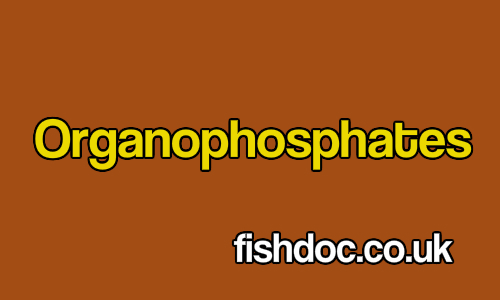This is a legacy document. It is NOT recommended that anyone use organophosphates for a fish disease or parasite. There are superior methods. However, Fishdoc.co.uk recognizes that in some regions of the world, organophosphates are “all they have” and are still used.
Far better for Flukes – Praziquantel
Far better for Argulus and Anchor Worm – Chitin Synthesis Inhibitors like Cyropro or Microbe Lift Anchor Worm Treatment
Organophosphates (OPs) as fish disease treatmentsOrganophosphates are used to treat monogenean flukes, Gyrodactylus (skin fluke) and Dactylogyrus (gill fluke), as well as leeches and crustacean ectoparasites Argulus (fish lice) and Lernaea (anchor worm). Organophosphates, work by interfering with the nervous system and thus affect vital physiological processes. OPs are potentially dangerous to both fish and humans and, for a variety of reasons, their use in fish disease control has been banned in many countries. There are currently safer alternatives being developed, but these are liable to be very expensive for hobbyists. The two most commonly used OPs are dichlorvos (DDVP) and trichlorfon (marketed as masoten, dipterex, and neguvon). The concentrations of active ingredients vary in the different trichlorfon preparations. When trichlorfon is added to water it degrades to DDVP, which then slowly degrades to less toxic by-products. Using OPsA major consideration in deciding the necessary dosage is the rate of breakdown of OPs from DDVP to less toxic by products. The quicker it breaks down, the higher the initial dose needs to be. The rate at which it degrades depends on various factors: light, high temperatures, aeration and high pH all speed up degradation. In mild temperatures and moderate pH the half-life can be several days, which means that it is active for longer. In alkaline conditions and high temperatures the half-life can be as short as a day. Usually 2 –3 doses a week apart (longer at cooler temperatures) are needed in order to deal with the emerging larvae and juveniles. The recommended rates for trichlorfon are:
A popular organophosphate used by koi keepers in the in the UK is masoten (Bayer). The recommended doses for this product are (Peter Waddington):
This product also comes in liquid form containing 20% active trichlorfon and is used at the rate of:
There is no doubt that OPs are extremely effective against parasites such as Argulus and Lernaea; and in almost all cases they will quickly clear a pond of these nasties. In addition to experiments to find alternatives or ‘safer’ organophosphate products there have been some experiments using chitin-inhibitors such as dimilin against these crustacean parasites. Because crustaceans larva, such as Argulus and Lernaea, undergo several molts before reaching maturity these products can interfere with the formation of new exoskeletons (an outer skeleton made mainly of a hard substance called chitin). There are mixed results with these products. More about organophosphates
|

